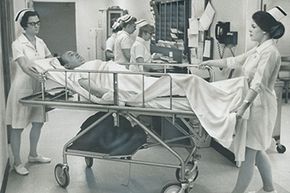"I need a crash cart here!" Long before this became a staple line of TV hospital dramas, there was a time when crash carts didn't exist. In those dark ages, medical personnel wasted precious time running around gathering up the necessary materials to care for critically ill patients. In 1968, a registered nurse (RN) in Buffalo, New York, finally had enough.
Anita Dorr had served as a U.S. Army nurse in both Europe and Africa during WWII and had risen to the rank of major. Having witnessed the effects of many of the infamous horrors of that conflict, including the concentration camps, she was committed to helping trauma victims as quickly and efficiently as possible.
Advertisement
Enlisting the aid of her husband, Dorr designed and built a small, red, wooden cart that had wheels, a laminated top, some shelves and a clipboard. She arranged materials on the top according to where on the patient's body they would be needed. Intubation items, for instance, were at the head, medications in the middle and intravenous materials at the foot. The invention, which was dubbed the "crisis cart," was an instant hit, and soon the entire hospital was full of them [source: Jezierski]. To control infection, the modern-day descendant of Dorr's cart is steel, not wood, and its supplies are disposable. But it still carries a clipboard!
Was Anita Dorr the inventor of the crash cart as we know it? She never obtained a patent, and others have laid claim to the title, but there's no doubt Dorr was among the first. And that was just one of her many accomplishments in the field of emergency nursing, a specialized discipline she helped create. Because once upon a time, there was no such thing as an official "emergency nurse." There wasn't even an emergency room!
Advertisement






